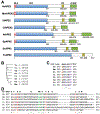Function and molecular mechanisms of APE2 in genome and epigenome integrity
- PMID: 34083046
- PMCID: PMC8287789
- DOI: 10.1016/j.mrrev.2020.108347
Function and molecular mechanisms of APE2 in genome and epigenome integrity
Abstract
APE2 is a rising vital player in the maintenance of genome and epigenome integrity. In the past several years, a series of studies have shown the critical roles and functions of APE2. We seek to provide the first comprehensive review on several aspects of APE2 in genome and epigenome integrity. We first summarize the distinct functional domains or motifs within APE2 including EEP (endonuclease/exonuclease/phosphatase) domain, PIP box and Zf-GRF motifs from eight species (i.e., Homo sapiens, Mus musculus, Xenopus laevis, Ciona intestinalis, Arabidopsis thaliana, Schizosaccharomyces pombe, Saccharomyces cerevisiae, and Trypanosoma cruzi). Then we analyze various APE2 nuclease activities and associated DNA substrates, including AP endonuclease, 3'-phosphodiesterase, 3'-phosphatase, and 3'-5' exonuclease activities. We also examine several APE2 interaction proteins, including PCNA, Chk1, APE1, Myh1, and homologous recombination (HR) factors such as Rad51, Rad52, BRCA1, BRCA2, and BARD1. Furthermore, we provide insights into the roles of APE2 in various DNA repair pathways (base excision repair, single-strand break repair, and double-strand break repair), DNA damage response (DDR) pathways (ATR-Chk1 and p53-dependent), immunoglobulin class switch recombination and somatic hypermutation, as well as active DNA demethylation. Lastly, we summarize critical functions of APE2 in growth, development, and diseases. In this review, we provide the first comprehensive perspective which dissects all aspects of the multiple-function protein APE2 in genome and epigenome integrity.
Keywords: APE2; ATR-Chk1 pathway; DNA demethylation; DNA repair; Genome and epigenome integrity; Immune response.
Copyright © 2020 Elsevier B.V. All rights reserved.
Conflict of interest statement
Declaration of Competing Interest The authors report no declarations of interest.
Figures





Similar articles
-
Apurinic/Apyrimidinic Endonuclease 2 (APE2): An ancillary enzyme for contextual base excision repair mechanisms to preserve genome stability.Biochimie. 2021 Nov;190:70-90. doi: 10.1016/j.biochi.2021.07.006. Epub 2021 Jul 21. Biochimie. 2021. PMID: 34302888 Review.
-
APURINIC/APYRIMIDINIC ENDONUCLEASE2 and ZINC FINGER DNA 3'-PHOSPHOESTERASE Play Overlapping Roles in the Maintenance of Epigenome and Genome Stability.Plant Cell. 2018 Sep;30(9):1954-1970. doi: 10.1105/tpc.18.00287. Epub 2018 Aug 22. Plant Cell. 2018. PMID: 30135084 Free PMC article.
-
APE2 Zf-GRF facilitates 3'-5' resection of DNA damage following oxidative stress.Proc Natl Acad Sci U S A. 2017 Jan 10;114(2):304-309. doi: 10.1073/pnas.1610011114. Epub 2016 Dec 27. Proc Natl Acad Sci U S A. 2017. PMID: 28028224 Free PMC article.
-
APE2 promotes DNA damage response pathway from a single-strand break.Nucleic Acids Res. 2018 Mar 16;46(5):2479-2494. doi: 10.1093/nar/gky020. Nucleic Acids Res. 2018. PMID: 29361157 Free PMC article.
-
Budding yeast Rad51: a paradigm for how phosphorylation and intrinsic structural disorder regulate homologous recombination and protein homeostasis.Curr Genet. 2021 Jun;67(3):389-396. doi: 10.1007/s00294-020-01151-2. Epub 2021 Jan 12. Curr Genet. 2021. PMID: 33433732 Free PMC article. Review.
Cited by
-
Large-scale analyses of the X chromosome in 2,354 infertile men discover recurrently affected genes associated with spermatogenic failure.Am J Hum Genet. 2022 Aug 4;109(8):1458-1471. doi: 10.1016/j.ajhg.2022.06.007. Epub 2022 Jul 8. Am J Hum Genet. 2022. PMID: 35809576 Free PMC article.
-
APE1 assembles biomolecular condensates to promote the ATR-Chk1 DNA damage response in nucleolus.Nucleic Acids Res. 2022 Oct 14;50(18):10503-10525. doi: 10.1093/nar/gkac853. Nucleic Acids Res. 2022. PMID: 36200829 Free PMC article.
-
Decoding Mycoplasma Nucleases: Biological Functions and Pathogenesis.Toxins (Basel). 2025 Apr 24;17(5):215. doi: 10.3390/toxins17050215. Toxins (Basel). 2025. PMID: 40423298 Free PMC article. Review.
-
APE2 Is a General Regulator of the ATR-Chk1 DNA Damage Response Pathway to Maintain Genome Integrity in Pancreatic Cancer Cells.Front Cell Dev Biol. 2021 Nov 2;9:738502. doi: 10.3389/fcell.2021.738502. eCollection 2021. Front Cell Dev Biol. 2021. PMID: 34796173 Free PMC article.
-
Understanding APE1 cellular functions by the structural preference of exonuclease activities.Comput Struct Biotechnol J. 2021 Jun 24;19:3682-3691. doi: 10.1016/j.csbj.2021.06.036. eCollection 2021. Comput Struct Biotechnol J. 2021. PMID: 34285771 Free PMC article. Review.
References
Publication types
MeSH terms
Substances
Grants and funding
LinkOut - more resources
Full Text Sources
Molecular Biology Databases
Research Materials
Miscellaneous

